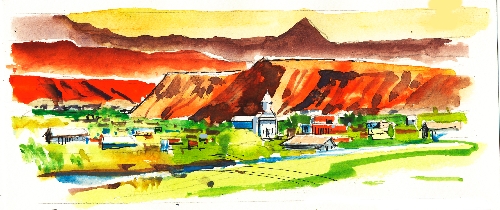Explore the history of St. George with easy self-guided tour

Autumn provides cooler temperatures for an absorbing walking tour through historic St. George, Utah. Nearly 30 vintage structures from the city’s pioneer era still stand within several blocks of old downtown. It includes early homes, businesses and public buildings. Pick up a printed guide for the stroll through history at the chamber of commerce office, now housed in the handsome old Washington County Courthouse on St. George Boulevard at 100 East.
St. George lies just 120 miles from Las Vegas on Interstate 15. To reach the historic downtown, exit the freeway at Bluff Street, turning left to access St. George Boulevard. Park somewhere near the old courthouse in the grid of streets laid out when Mormon settlers arrived in the 1860s. Visitors taking the self-guided tour benefit from the wide tree-lined streets, colorful gardens, orchards and plantings pioneer planners envisioned.
Typical of stately courthouses constructed in the 19th century, the start of the walking tour retains its distinction, a sturdy, two-story red brick edifice with cupola on top and contrasting white trim. Inside, vintage details in woodwork, ceilings and fixtures demonstrate the durability of craftsmanship of the day.
The tour next makes a stop at the Daughters of the Utah Pioneers Museum, housed in a squatty structure from a later era. Exhibits inside provide insights into the challenges and hardships endured by those first families sent by their church to southwestern Utah to make the desert bloom and produce.
Just beyond the museum, the elegant restored opera house anchors an area used for community events since frontier times. In summer, visitors assemble at the opera house to meet costumed guides who provide historical details of early St. George for a small fee.
The walking tour passes many historic homes that are still active residences, not open to public visitation. A few repurposed venerable residences house guests as quaint bed and breakfast inns. One of the finest old residences, Brigham Young’s gracious, 1873 summer home, welcomes guests to join a small guided group. Guides dressed in 1870s’ garb lead tours through the house. The residence features many refined details, such as woodwork and furniture faux-painted to look like exotic woods instead of pine logged nearby and milled locally.
The early Mormon leader conducted church and territory business while living part of the year in the milder climate of Southern Utah. A telegraph station on the property kept him abreast of national and territorial affairs. Among many shade trees on the property, venerable mulberry trees were originally planted to feed silk worms whose cocoons provided silk for making fabric. Known as Utah’s “Dixie,” the area also contributed cotton, important after the Civil War interrupted access to the South’s cotton. Creating as many products for themselves as possible made the early pioneers independent, self-reliant and inventive.
When the pioneer groups fanning out from Salt Lake City to colonize reached southwestern Utah, they found some usable water, sagebrush and red sand. In a handful of years, a young city rose from the desert, but not without hardships, tragedies, disaster and unrelenting labor.
While building homes, establishing businesses, creating farms and raising livestock, pioneers also donated time to construct roads and several buildings for use by the church and the community. On the walking tour, visitors see the beautiful meeting house called the Tabernacle, one of those early public works projects. A soaring 140-foot steeple and elegant twin outside staircases distinguish this grand structure started in 1863 and still in service. It boasts wonderful acoustics, important in an era preceding sophisticated sound systems.
The most distinctive building in old St. George is not on the walking tour, the dazzling white St. George Temple. Begun in 1871 and dedicated in 1877, the stone building became the first Mormon temple in use in Utah. Visitors often drive from downtown to reach the square centered on the temple. Park and stroll the lovely, landscaped grounds. The temple’s visitor center provides information and details. The building itself remains open only to Mormons in good standing.
Margo Bartlett Pesek’s column appears on Sundays.